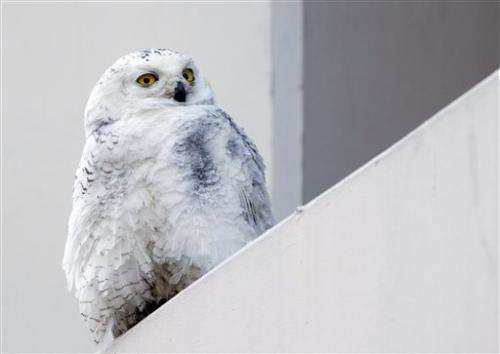In this Jan. 24, 2014 file photo, a snowy owl rests on a ledge of a building in Washington. Reports from tens of thousands of bird-counting volunteers show a southern invasion of Arctic-dwelling snowy owls has spread to 25 states, and frigid cold is causing unusual movements of waterfowl. (AP Photo/Manuel Balce Ceneta, File)
Reports from tens of thousands of bird-counting volunteers show a southern invasion of Arctic-dwelling snowy owls has spread to 25 U.S. states, and frigid cold is causing unusual movements of waterfowl.
Results are still coming in from the four-day annual Great Backyard Bird Count sponsored by the Cornell Lab of Ornithology, the National Audubon Society and Bird Studies Canada. Sponsors say the event, which ended Monday, drew participants from a record 127 countries, surpassing last year's 110. Most were from the U.S. and Canada.
Preliminary results show more than 2,500 snowy owls being reported in 25 states and seven Canadian provinces. The big white owls are in the midst of a sudden invasion of a region in large numbers, which scientists attribute to a population boom in the birds and a scarcity of their preferred food, lemmings, in their normal range on the Arctic tundra.
The Great Backyard Bird Count is designed to engage the public in nature study as well as help scientific research.
"When tens of thousands of participants around the world share what they're seeing during the Great Backyard Bird Count, they help scientists achieve something that would otherwise be impossible—documenting where vast numbers of birds are, all across the world, in a very short period of time," said Janis Dickinson, director of citizen science at the Cornell Lab in Ithaca.
The annual backyard count, now in its 17th year, is open to anyone. Participants observe and record birds in their backyard or any other location for at least 15 minutes on one or more days of the count and submit the observations online.
Anyone can view the results and explore trends in bird distribution and numbers online at www.ebird.org.
© 2014 The Associated Press. All rights reserved.




















